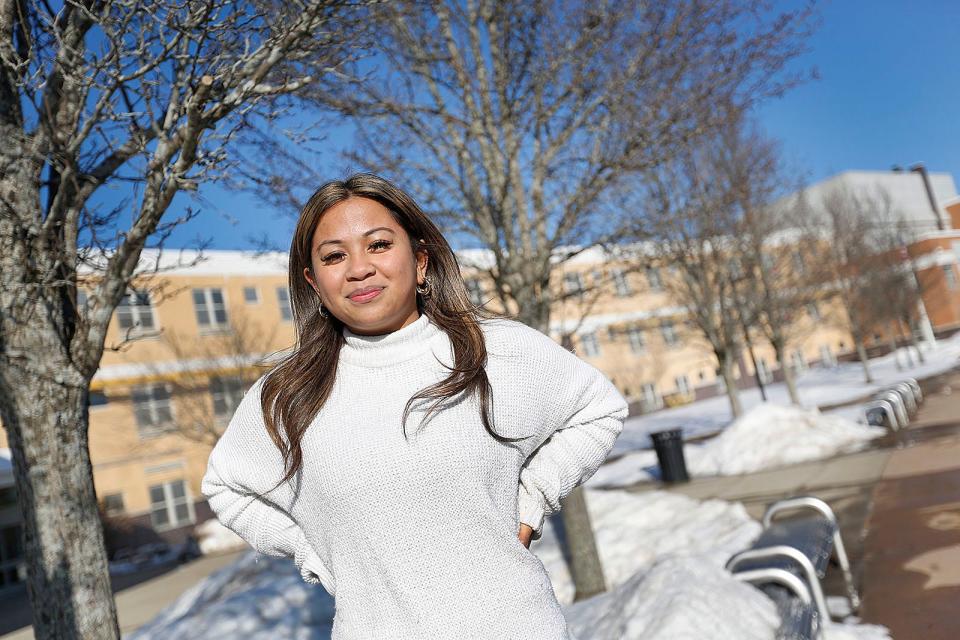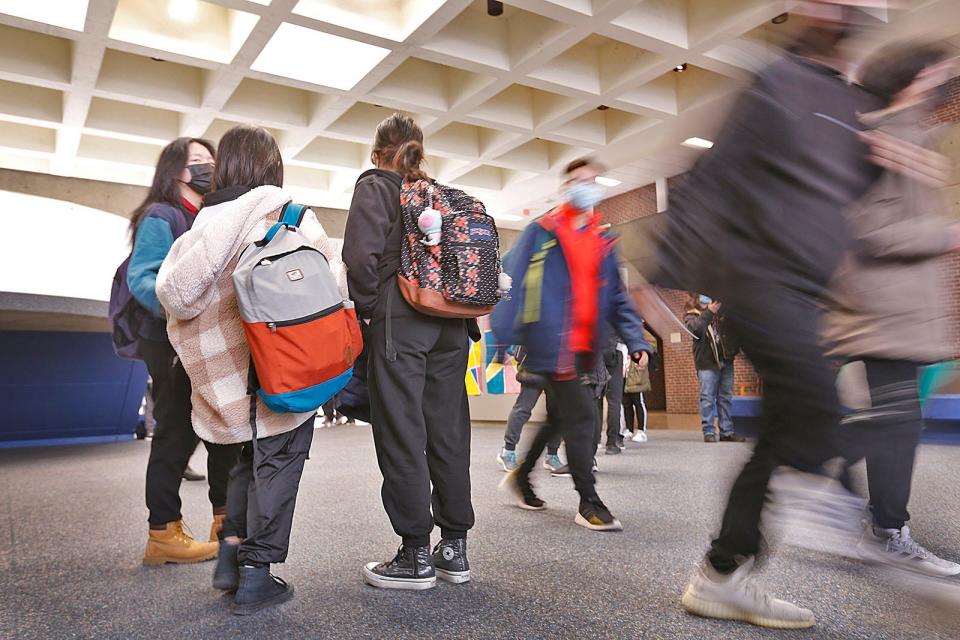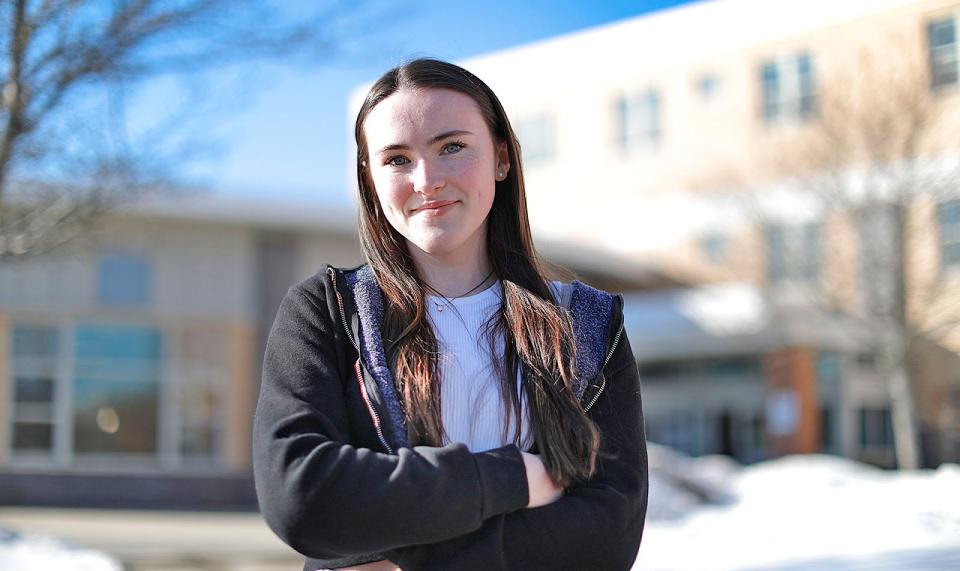College admissions. Pandemic. School safety. Students say they are stressed out.
Applying to colleges, trying to ace Advanced Placement classes, leading sports teams and clubs and finding time to hang with friends before moving to campuses far away. Those are some of the challenges high school students face during "normal" times.
In a pandemic, those challenges have grown, and so have students' stress and anxiety, some say.
"Being remote last year really took a toll on how I see education," Weymouth High senior Devyn Krall, 17, said. "It was just upsetting ... so many aspects as to why it wasn't a good year."
"We're rushing straight into things," fellow senior Rayah Sibunga, 17, said of the shift from remote to in-person learning. "Students aren't used to that. That takes a big toll."

"Anxiety levels have definitely risen," senior Annelise Rogers, 18, said.
Students agree: The last few years have been weird, stressful and, for many, anxiety-inducing.
Will your school drop the mask mandate?: Here's where South Shore districts stand
Masks in sports: MIAA announces it will drop mask mandate at the end of the month
Teens are up against a lot right now: the pandemic, social isolation, social unrest, school shootings, other threats to school safety. So it's no surprise that some studies show an increase in stress, anxiety and depression in teens since the pandemic began.
More than 70% of parents surveyed in a 2020 national poll conducted by the Ann & Robert H. Lurie Children’s Hospital of Chicago said the pandemic has taken a toll on their child's mental health.
Local experts and students say they've noticed the increase in stress and anxiety, and the feelings are caused by a number of factors.
Social isolation despite social media
Barbara Green, a licensed psychologist who co-founded the Center for Integrative Counseling and Wellness in Hingham nearly a decade ago, said there is a clear link between adolescent use of social media and increasing reports of anxiety, depression and other mental health issues.
Reports of eating disorders, body image issues, suicidal thoughts and other problems have increased, Green said. When children use social media, posts spread quickly, often without supervision.
"We're giving them the keys to a race car Ferrari when they have no idea how to drive," Green said.
A September story by the Wall Street Journal reported that Instagram, owned by Meta, has been shown by the company's own researchers to damage teen girls' body image.

The social media platforms children use are constantly morphing, Green said, but often the effects are the same. Kids see other users talk about how great their life is and then feel worse in comparison.
“The sense of unbridled exposure that comes with social media," Green said, "whether it's kids comparing themselves to others in a way that they don’t measure up or they think everyone is happy and they’re not. ... whether it's Snapchat or Instagram, the ways in which life can look perfect for others is extraordinarily difficult for many.
Exclusive poll: Overwhelming majority says the US faces a mental health crisis
See the numbers in your town: Local COVID-19 cases nearly cut in half in latest weekly state report
“It’s just a completely unregulated, uncensored experience for kids today.”
Rogers' senior year capstone project at Weymouth High will analyze the link between social media and issues such as body dysmorphia, she said.

Experts say distress has grown
A report by Elizabeth Englander, the executive director of the Massachusetts Aggression Reduction Center at Bridgewater State University, outlines the effects of emotional distress and bullying among young people during the pandemic. The study, published in September 2021, surveyed 240 university students ages 17 and up between January and April 2021.
Nearly three-quarters of all students surveyed reported an increase in anxiety, depression or both since the pandemic began. Stressors included seeing someone close to them contract COVID-19 and the loss of school normalcy.
The report states that the most significant sources of stress among students were social isolation and the loss of school opportunities and work.
“Financial stressors, being confined for extended periods of time with family, missing friends and other close social relationships, and similar factors could certainly account for anxiety and depression,” the report states.
Green emphasizes the differences between stress, anxiety and depression in children.
Stress is something everyone experiences, a feeling that ebbs and flows over time. But anxiety changes how children act, Green said.
"Anxiety in younger children can often be seen in reluctance and inability to continue in their normal routine," she said. Children might experience stomach aches or be more timid.
My dog is my Valentine: South Shore pet owners splurge on the day of love
'It's been a tough ride': In the age of omicron, South Shore clubs face the music
For older adolescents, anxiety often causes teens to withdraw from their peer groups.
Being anxious is more than just feeling nervous or worried, she said. Anxiety can cause avoidance in teens and affect their development and ability to have positive social relationships. If not treated, that anxiety can lead to depression.
Adults need to take action
Beyond the stressors caused by the pandemic, national events like the murder of George Floyd, an unarmed Black man killed by police in Minneapolis, and the country's reckoning with racism have sparked local conversations and protests.
On the South Shore, several schools this past fall saw students stage walkouts to protest racism, hate speech and a dearth of school curricula that represents them, students said.
When students feel heard in their classes, they benefit, Green explained.
“Kids really want to feel heard and understood and represented and know what they think and feel matters,” she said.
Forced to pivot during pandemic: More South Shore women open their own businesses
South Shore real estate town by town: No. 1 sale at $2.5M has private walking trail to Cohasset Golf Club
For some students, school doesn't feel like a safe place to share their feelings.
At a Quincy School Committee meeting Dec. 8, Assistant to the Superintendent Laura Owens read letters from parents and other city residents, including one that described concerns for students' safety in school.
"What I have witnessed in our community is a highly distressed population of young people who don't feel safe at school," Gertrude McDonald wrote. "Moreover, they don't even feel they can safely share their stories."
McDonald wrote that when children don't feel safe, they become stressed and unable to learn in a school environment. This stress grows when students don't feel comfortable sharing their thoughts and feelings, she said.
"It is not surprising that so many children feel stressed out and desperate enough that they had to choose a walkout as a way of communicating with other community members, especially with us adults," she wrote. "These children need us to take actions."
Police visit local schools after reported concerns
Even school violence in other towns can cause stress to students, they said.
In a one-week span, three South Shore school districts had an increased police presence on campus after possible threats were reported.
On Dec. 6, authorities reported that three Whitman-Hanson High School students would face charges after making threats on social media. The charges resulted from a Snapchat post showing one Whitman-Hanson student holding a realistic-looking pellet gun with a caption telling people not to go to school Monday.
Two days later, Pierce Middle School in Milton went on lockdown after a student reported an adult in the school who may have been carrying a weapon. School staff and Milton police found the adult had been carrying a phone charger, which the student mistook for a weapon.
The next day, officers visited Hingham Middle School after police were informed of a Snapchat group chat among students that referenced a past shooting threat. The school was not in danger at the time, police determined, though officers remained at the school throughout the day.
The separate incidents came days after a school shooting in Michigan, where four students were killed by a fellow student with a gun. It was the 28th school shooting of 2021.
The national news of shootings has changed "normal" expectations for some students, they said.
Krall said it's scary for her to think about attacks at school.
"I don't think it's something that wouldn't happen anymore," she said. "I know where most of the exits in my school are."
The day after the Whitman-Hanson incident, Sibunga didn't want to go to school, she said.
"It's so normalized in our country," she said. "It produces significant stress for me."
Get the new Coronavirus Watch newsletter: Sign up here
Thanks to our subscribers, who help make this coverage possible. If you are not a subscriber, please consider supporting quality local journalism with a Patriot Ledger subscription. Here is our latest offer.
Reach Alex Weliever at aweliever@patriotledger.com.
This article originally appeared on The Patriot Ledger: Students' stressors include the pandemic, school shootings and college applications

